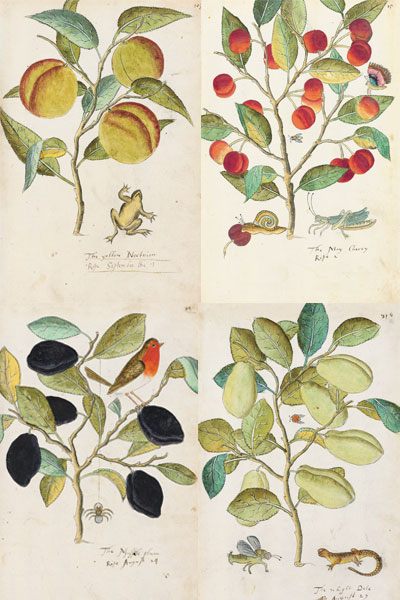Elias Ashmole, fortune-hunter, scholar and collector, bequeathed his coins, curiosities and books in 1692 to form the nucleus of the Ashmolean Museum in Oxford. The books were later taken over by the Bodleian Library. One of them is called The Tradescants’ Orchard, from a tenuous association with John Tradescant I, Keeper of Gardens, Vines and Silkworms to King Charles I, and his nurseryman son John II. It is edited by the historian of the world’s apples and his Oxford colleague in art history.
The book consists of 64 pen-and-watercolour pictures of different varieties of plums and peaches and a few other fruits in a vivid and charmingly primitivist style — enlivened by colourful sketches of imaginary snails, spiders, caterpillars, butterflies, frogs and birds, anticipating Beatrix Potter.
A strawberry and a gooseberry by different hands were added; someone hastily labelled the pictures with variety names and fruiting dates; a bookbinder chopped off the edges of the sheets and bound them into a volume; Ashmole wrote an index; his bookbinder made a new binding, held shut with brass clasps in a long-disused medieval style. As loose sheets they were pawed over by many grubby fingers, and after the second binding the book was used until it began to fall apart. Who painted them? Who consulted them and why?
The pictures try to show the colours, shapes and sizes of different cherries, plums, peaches etc. The craft of botanical illustration (which is different from artistic art) was well advanced at the time, for example in the great herbal of John Parkinson, the Tradescants’ friend. This artist was not a botanical illustrator, and was unaware of the subtler features — leaves, twigs, hairs — that distinguish one variety from another. Although a few of the names are still in use for what may or may not be the same variety, the editors offer no identification of the pictures themselves with varieties still extant or known from later pictures. With few exceptions, like ‘The whight Date’ (a plum looking like a green lemon, illustrated on the previous page, bottom right) or ‘The Jerusalem peere’ (a striped pear), the paintings are hardly good enough to identify them.
The editors have studied this beautiful manuscript for many years. They date it to between 1620 and 1650. They speculate that the pictures were, in effect, the catalogue of a travelling nurseryman offering new fruit varieties to customers. The artist is still unknown, and the Tradescant association is still tenuous. The Orchard keeps its mystery.






Comments